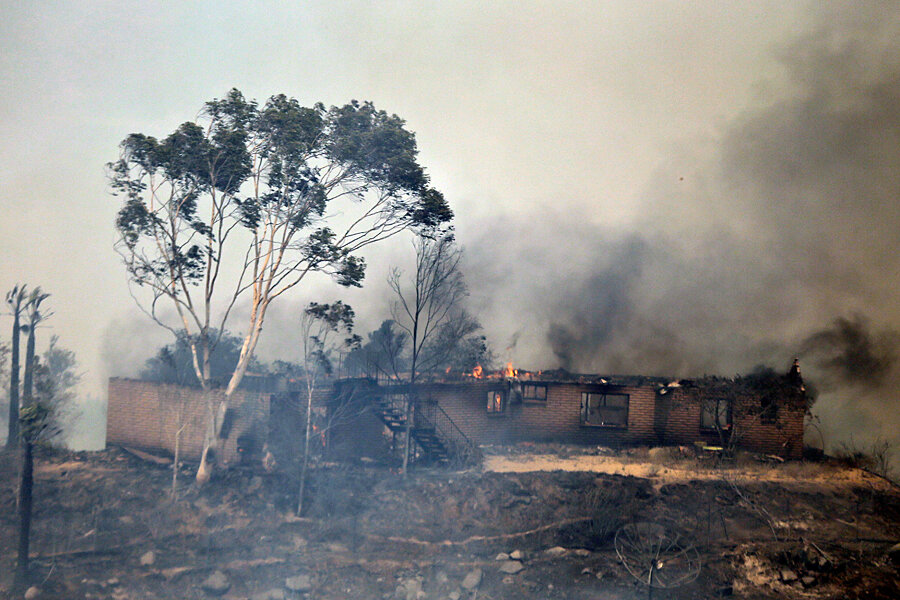San Marcos fire: One of nine California wildfires roars to life
Loading...
| SAN MARCOS, Calif.
One of the nine fires burning in San Diego County suddenly flared Thursday afternoon and burned close to homes, trigging thousands of new evacuation orders.
The flare-up near the city of San Marcos occurred after a half-day lull in winds that firefighters had seized as an opportunity to make progress against flames that have scorched thousands of acres this week.
Ash-laden smoke was so thick that visibility was limited to a few feet at times. On one semi-rural street, five horses wandered nervously in a paddock as firefighters worked to protect nearby homes and barns.
County Sheriff Bill Gore said new evacuation notices were transmitted to 12,952 phone numbers. They were in addition to more than 20,000 evacuation orders issued Wednesday.
State fire Capt. Kendal Bortisser said the fire was running east along hillsides behind California State University San Marcos.
The fire was being driven by fuel and topography, said Division Chief Dave Allen of the California Department of Forestry and Fire Protection.
"It's created its own weather pattern there as it sucks oxygen in," he told a news conference.
The 1,000-acre blaze was only 5 percent contained. The fire, which broke out Wednesday, forced the evacuation of the California State University campus where nearly 10,000 students were in the middle of final exams. Graduation ceremonies were canceled.
Fires began erupting in the county Tuesday amid high heat, extremely low humidity and gusty Santa Ana winds. By Wednesday, nine fires were burning.
Asked about the possibility of arson, the sheriff said he wouldn't prejudge the investigations. He noted that sparks from vehicles can easily ignite brush in such dry conditions.
Emergency officials said a significant number of firefighting aircraft had become available, including four air tankers and 22 military helicopters, in addition to local agency helicopters.
Ten of the military helicopters were being used to battle a blaze that grew to 9.37 square miles on the Marine Corps' Camp Pendleton. Despite its growth, the fire was 20 percent contained and was no longer considered a threat to communities.
Twelve other military helicopters were available to the county.
Since the fires began, 125,000 evacuation notices have been sent, officials said. Schools also have been shut down and the Legoland amusement park had to close Wednesday. It reopened Thursday.
Firefighters contended with temperatures approaching 100 degrees and gusty winds as they tried to contain flames fueled by brush and trees left brittle by drought.
There was extreme heat again Thursday, with temperatures ranging in the high 90s to 100 in the northwestern area of the county where the fires burned.
The heat was so intense that records continued to be broken in Southern California and horse racing was canceled at Santa Anita Park in Arcadia, east of Los Angeles.
Officials said a Carlsbad-area blaze was 75 percent contained and had burned 400 acres. The wildfire destroyed an 18-unit condominium complex and four residences, Carlsbad Mayor Matt Hall said.
Some evacuation orders were being lifted in Carlsbad, but a major power outage and hotspots were still a concern.
Tuzo Jerger was one of thousands told to evacuate because of the Carlsbad fire. The 66-year-old real estate broker packed files, a surfboard, golf clubs, clothes and photos and sought solace at a friend's hilltop house in nearby San Marcos, only to see a wildfire break out there and force thousands from their homes.
"I thought, 'Oh my God, it's going to come this way,'" Jerger said at a San Marcos restaurant where he found relief in a slice of pizza.
The blaze in the coastal city of Carlsbad, about 30 miles north of San Diego, was the most destructive of the fires so far.
Many schools across the county were closed Thursday. Officials expected some wouldn't reopen until next week.
Gov. Jerry Brown declared a state of emergency for San Diego County, which would free up special resources and funding for the firefight, and state fire officials were creating a central command center for the blazes.
Drought conditions have made fire danger extremely high throughout much of California. Officials have encouraged residents in fire-prone areas to prepare evacuation plans and clear brush from near their homes.
Carlsbad's fire chief said the blazes were unprecedented in his 27-year firefighting career because they are so early in the year.
"This is May. This is unbelievable. This is something we should see in October," Chief Michael Davis said. "I haven't seen it this hot, this dry, this long in May."
____
Watson reported from San Diego. Contributing to this report were AP photographer Lenny Ignelzi and videographer Raquel Maria Dillon in San Marcos, and AP writers Robert Jablon and John Antczak in Los Angeles.







